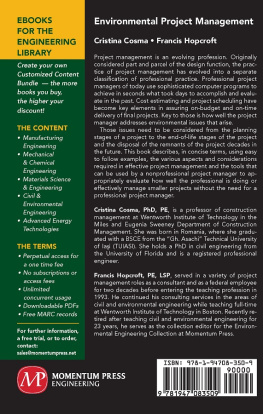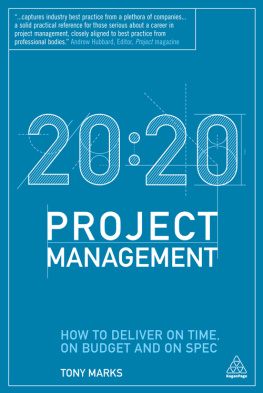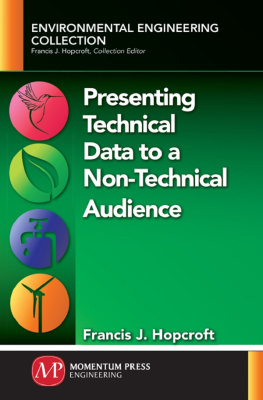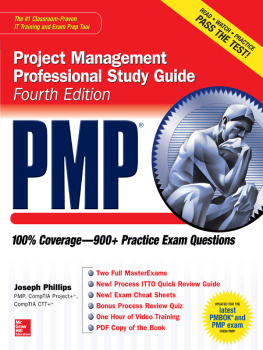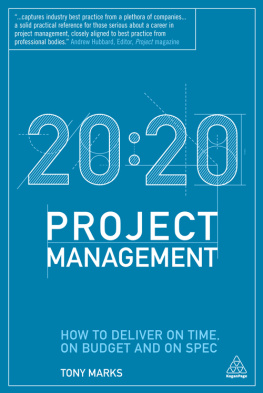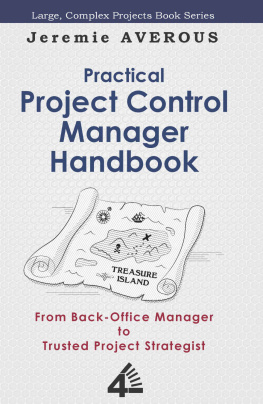ENVIRONMENTAL
PROJECT
MANAGEMENT
ENVIRONMENTAL
PROJECT
MANAGEMENT
CRISTINA COSMA
FRANCIS HOPCROFT

Environmental Project Management
Copyright Momentum Press, LLC, 2019.
All rights reserved. No part of this publication may be reproduced, stored in a retrieval system, or transmitted in any form or by any meanselectronic, mechanical, photocopy, recording, or any otherexcept for brief quotations, not to exceed 250 words, without the prior permission of the publisher.
First published in 2019 by Momentum Press, LLC
222 East 46th Street, New York, NY 10017
www.momentumpress.net
ISBN-13: 978-1-94708-350-9 (print)
ISBN-13: 978-1-94708-351-6 (e-book)
Momentum Press Environmental Engineering Collection
Cover and interior design by S4Carlisle Publishing Services Private Ltd., Chennai, India
First edition: 2019
10 9 8 7 6 5 4 3 2 1
Printed in the United States of America
A BSTRACT
Project management is an evolving profession. Originally considered part and parcel of the design function, the practice of project management has evolved into a separate classification of professional practice. Professional project managers of today use sophisticated computer programs to achieve in seconds what took days to accomplish and evaluate in the past. Cost estimating and project scheduling have become key elements in assuring on-budget and on-time delivery of final projects. Key to those is how well the project manager addresses environmental issues that arise. Those issues need to be considered from the planning stages of a project to the end-of-life stages of the project and the disposal of the remnants of the project decades in the future. This book describes, in concise terms, using easy to follow examples, the various aspects and considerations required in effective project management and the tools that can be used by a nonprofessional project manager to appropriately evaluate how well the professional is doing or to effectively manage smaller projects without the need for a professional project manager.
KEYWORDS
cost estimating, environmental management, environmental project management, project management, scheduling
C ONTENTS
When the last tree is cut down, the last fish eaten, and the last stream poisoned, we will realize that we cannot eat money.
Paraphrased from Obomsawin, 1972
Environmental project management can be described as nothing more than regular project management, but with an environmental twist. In one sense that simplicity is good, but in another, it misses the whole point of the concept. A distinction is also often made between the general management of an environmental project and the environmental management of a general project. The difference is not entirely semantic, but is sufficiently close to being so that the rules and concepts applicable to the first are equally applicable to the second.
In this book, the discussion is focused on the environmental management of any project and any project that directly impacts the environment requires effective environmental management. The environment includes the physical space around, under, over, and adjacent to the project footprint. It is not only endangered species of flora and fauna that may be impacted, positively or negatively, but also the social (community infrastructure, resources, and recreation areas) and human (health, financial, and similar) environments impacted by the project. Shading and shadows cast over large areas by tall structures can create temperature islands within the shadow zones. Tall towers of open grid design can become homes for raptors, or traps for migrating birds. Marine structures can vibrate in the wind at frequencies not heard by people, but incredibly disruptive to marine life for miles around the site. And pathways of movement used by various migrating land animals can be so severely disrupted by a single road that a species is eliminated from a local environment, and sometimes, from the world.
In short, all projects impact environments of one kind or another in some way, most often negatively. Effective environmental management of a project can mitigate or eliminate negative environmental impacts, and in some cases, provide positive impacts that can help to offset decades of negative impacts from prior projects.
There are many ways to classify project types. For purposes of discussion within this book, there are two types of projects: those that are environmental and those that are not. Environmental projects involve direct attempts to alter, control, or disrupt an existing environmental condition. Examples include, among many others, the rerouting of a stream or river; the construction of flood control structures; the construction of created wetlands for pollution control; the elimination of pollutant discharges to land, water, or air; the construction or removal of dams on rivers and streams; and the re-creation of fish passage along historic stream beds.
Regardless of the type of project, however, no project lasts forever. To be sure, there are examples of projects built in antiquity that have survived for centuries, and may even still be in regular use today. The vast majority of projects, however, have a much shorter and more finite life. At some point, they cease to function as designed and are either destroyed to make room for new projects or allowed to degrade and disintegrate into the local environment. If left alone long enough, all man-made structures and artifacts would eventually degrade to their elemental forms and return to the earth from which they arose. The time it takes for that to happen, the life cycle of the structure or artifact, can be highly variable but inevitable.
When considering the impacts of an anthropogenic project, the expected life cycle needs to be considered. The importance of that concept is that various materials used, or potentially used, in any construction project, will have different life cycles. Various types of wood, for example, will rot in different climates at different rates. Concrete is not a universal material, and it will decompose at rates that can vary widely depending on the local environment, the initial design strength of the concrete, the structural loads placed on it, and the effects of local flora on the integrity of the concrete element. Similar degradation rates can be defined for earthworks, such as dams and levees, bricks, stone, glass, plastics, and most other material used in construction. What that degradation will look like, how it will be managed, and how the degraded materials can be effectively handled at the end of their life cycle are all important considerations in the environmental management of projects.
Almost every project of significant size or scope involves a contract between the owner (the person or entity paying for the work) and the designer, and a separate contract between the owner and the builder of the project. There is also often an owners project manager (OPM) involved to act in the stead of the owner during design and construction. Those contracts require coordination between the three or four parties so that the owner ends up with a product as designed by the designer. Subcontractors may also be involved, with contracts directly between the general contractor and the subcontractor. Material suppliers may have contracts directly with any of the parties, depending on the terms of the various construction contracts, but those contracts are usually between the contractor and the vendor or the subcontractor and the vendor. Service contracts, such as for material testing, may be between the laboratory and either the owner, the owners project manager, the designer, or the contractor.

